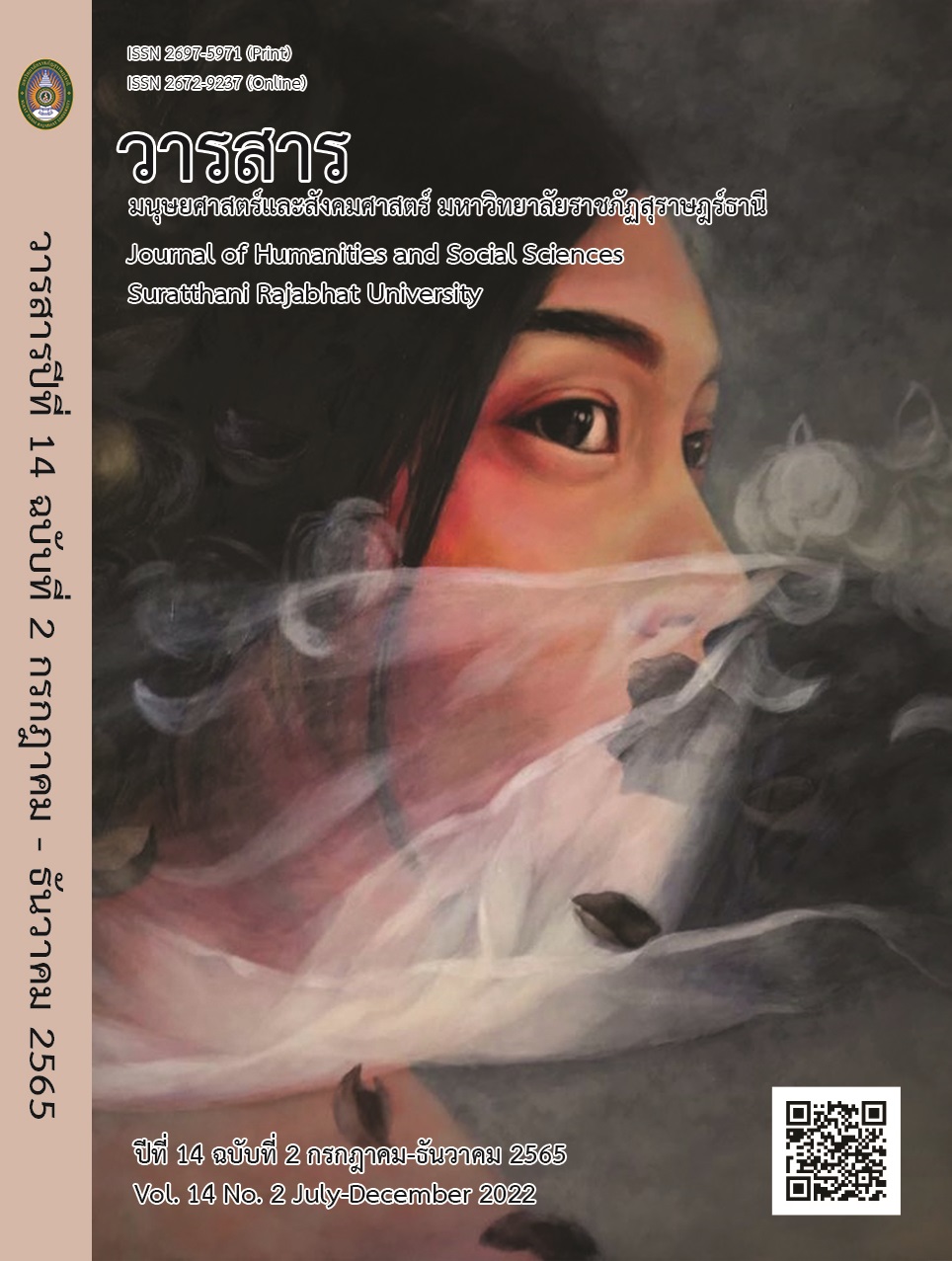Critical Literacy: An Alternative Way in Language Classrooms
Main Article Content
Abstract
Critical literacy is the method to consider how the texts appear in writing and speaking. It can manipulate text, images, sound, and various multimedia for questioning, including the thought, values, and beliefs
produced by society. It focuses on learners which consist of 4 principles
using critical literacy in the language classroom are: 1) generation, which is to generate the code, which defines the title, concept, or situation. It must be something that can allow learners to practice thinking and try to decipher it; 2) examination and creation, is to examine the information and create a critical framework from the subject or situation that the learner receives. By connecting them with their own experiences and values to lead to analysis and critique the subject or situation; 3) reflection, is to reflect the information gained from experience by expressing feelings, thoughts, or tone of things or situations; and 4) action and presentation, is to present solutions to
problems through activities such as discussions, seeking answers. Presenting solutions for behavior change as well as creating their work or writing their text. Therefore, critical literacy is an alternative to organizing learning activities in the classroom language. So, the learners will improve their way of thinking and know the possibilities and possibilities of any situation in this complicated world.
Article Details

This work is licensed under a Creative Commons Attribution-NonCommercial-NoDerivatives 4.0 International License.
All published manuscripts have been verified by peer-peer professors in the fields of humanities and social sciences. Reprinting of the article must be authorized by the editorial staff.
References
ธิดา แซ่ชั้น, และ ณรงค์ สมพงษ์. (2562). การพัฒนาแบบจําลองการเรียนการสอนบนเว็บ
โดยใช้ปัญหาเป็นฐานเพื่อส่งเสริมการรู้ดิจิทัลสำหรับนักศึกษาระดับปริญญาตรี.
วารสารสารสนเทศศาสตร์, 37(2), 21-43.
นภดล ร่มโพธิ์. (2564). The Lost Skill ทักษะที่หายไปในศตวรรษที่ 21. กรุงเทพฯ: WE
LEARN.
สุธิญา พูนเอียด (ผู้จัดทำภาพ). มโนทัศน์สำคัญของการเรียนรู้เชิงวิพากษ์. ณ
กองบัญชาการกองทัพเรือ พระราชวังเดิม. เมื่อวันที่ 25 ธันวาคม 2564.
สุธิญา พูนเอียด (ผู้จัดทำภาพ). แนวทางการจัดการเรียนการสอนการเรียนรู้เชิงวิพากษ์. ณ
กองบัญชาการกองทัพเรือ พระราชวังเดิม. เมื่อวันที่ 25 ธันวาคม 2564.
ศศิมา ตุ้มนิลกาล. (2560). การนําเสนออัตลักษณ์บนเครือข่ายสังคมออนไลน์อินสตาแกรม
ของเจเนอเรชั่น:กรณีศึกษาความแตกต่างระหว่างเจเนอเรชั่นเอ็กซ์ เจเนอเร
ชั่นวายและเจเนอเรชั่นแซด. การค้นคว้าอิสระ นศ.ม. (การสื่อสารเชิงกลยุทธ์).
กรุงเทพฯ: บัณฑิตวิทยาลัย มหาวิทยาลัยกรุงเทพ.
Alastair, P. (2001). Critical applied linguistics: A critical introduction. New
Jersey: Lawrence Erlbaum Associates.
Anderson, G. L., & Irvine, P. (1993). Informing critical literacy with ethnography.
In Critical literacy: Politics, praxis, and the postmodern. New York:
Suny Press.
Anderson, L. W., & Bloom, B. S. (2001). A taxonomy for learning, teaching,
and assessing: A revision of Bloom's taxonomy of educational objectives.
New York: Addison Wesley Longman.
Bobkina, J., & Stefanova, S. (2016). Literature and critical literacy pedagogy in
the EFL classroom: Towards a model of teaching critical thinking
skills. Studies in second language learning and teaching, 6(4), 677-
Bobkina, J., & Stefanova, S. (2016). Model of teaching critical thinking skills:
Reader-centered critical reading and critical literacy pedagogy. In
Literature and critical literacy pedagogy in the EFL classroom:
Towards a model of teaching critical thinking skills. 684. Studies in
second language learning and teaching.
Bogart, W. G. V. D. (2008). Search Strategies in the IT and Internet Era. The
need for critical literacy and critical thinking in knowledge workers.
http://www.earthportals.com/Portal_Messenger/ss.html
Cervetti, G., Pardales, M. J., & Damico, J. S. (2001). A tale of differences: Com
paring the traditions, perspectives, and educational goals of critical
reading and critical literacy. Reading online, 4(9), 80-90.
Chaikul, R. (2006). Application of critical literacy to enhance English speaking
ability and critical consciousens of Janpanese students. Master of
Education M.Ed. (Teaching English as a Foreign Language). Chiang Mai:
Chiang Mai University.
Chaikul, R. (2006). Concept of critical literacy. In Application of critical literacy
to enhance English speaking ability and critical consciousens of
Janpanese students. 22. Chiang Mai: Chiang Mai University.
Chaikul, R. (2006). The cycle of the application of critical literacy. In Application of
critical literacy to enhance English speaking ability and critical
consciousens of Janpanese students. 31. Chiang Mai: Chiang Mai
University.
Cummins, J. (2000). Academic language learning, transformative pedagogy,
and information technology: Towards a critical balance. Tesol
Quarterly, 34(3), 537-548.
Darder, A. (2003). The critical pedagogy reader. New York: Psychology Press.
Freire, P. (1972). Education: domestication or liberation?. Prospects, 2(2),
-181.
Freire, P. (1993). Pedagogy of the City. New York: Continuum.
Freire, P. (2005). Pedagogy of the oppressed. New York: Continuum.
Giroux, H. A. (2004). Critical pedagogy and the postmodern/modern divide:
Towards a pedagogy of democratization. Teacher education
quarterly, 31(1), 31-47.
Locke, T., & Cleary, A. (2011). Critical literacy as an approach to literary study
in the multicultural, high-school classroom. English Teaching:
Practice and Critique, 10(1), 119-139.
Luke, A. (2000). Critical literacy in Australia: A matter of context and
standpoint. Journal of adolescent &adult literacy, 43(5), 448-461.
McLaren, P. (1998). Che: The pedagogy of Che Guevara: Critical pedagogy
and globalization thirty years after Che. Cultural Circles, 3, 29-103.
Michell, M. J. (2006). Teaching for critical literacy: An ongoing necessity to
look deeper and beyond. English Journal, 96(2), 41-46.
Ohara, Y., Saft, S., & Crookes, G. (2001). Toward a feminist critical pedagogy
in a beginning Japanese-as-a-foreign-language class. Japanese
Language and Literature, 35(2), 105-133.
Rivera, K. M. (1999). Popular research and social transformation: A community-based
approach to critical pedagogy. TESOL Quarterly, 33(3), 485-500.
Stefanova, S., Bobkina, J., & Pérez, F. J. S.-V. (2017). The effectiveness of
teaching critical thinking skills through Literature in EFL context: A
case study in Spain. International Journal of Applied Linguistics and
English Literature, 6(6), 252-266.
Temple, C. (2016, December 28). Critical Thinking and Critical Literacy. http://
www.criticalthinkinginternational.org/further-reading?id=22
Van Duzer, C., & Florez, M. C. (1999). Critical Literacy for Adult English
Language Learners. https://www.cal.org/caela/esl_resources/
digests/critlit.html
Wooldridge, N. (2001). Tensions and ambiguities in critical literacy. In
Negotiating critical literacies in Classrooms. New York: Routledge.


